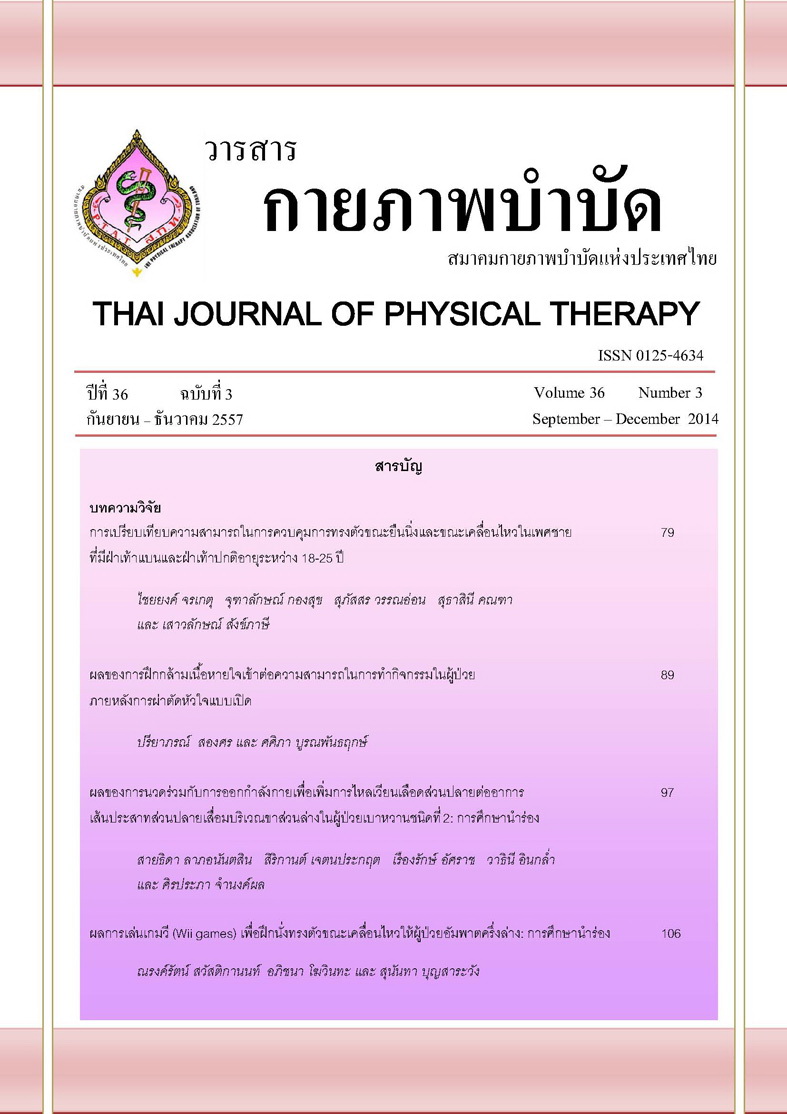ผลของการฝึกกล้ามเนื้อหายใจเข้าต่อความสามารถในการทำกิจกรรมในผู้ป่วยภายหลังการผ่าตัดหัวใจแบบเปิด
Main Article Content
บทคัดย่อ
การผ่าตัดหัวใจแบบเปิด มักเกิดภาวะแทรกซ้อนต่างๆ รวมทั้งความสามารถในการทำกิจกรรมลดลง การรักษาทางกายภาพบำบัด ได้แก่ การฝึกการหายใจ เป็นวิธีหนึ่งที่สามารถเพิ่มความสามารถในการทำกิจกรรม ส่งผลให้ผู้ป่วยมีคุณภาพชีวิตที่ดีขึ้น วัตถุประสงค์: เพื่อศึกษาผลของการฝึกกล้ามเนื้อหายใจเข้า ต่อความสามารถในการทำกิจกรรมในผู้ป่วยภายหลังการผ่าตัดหัวใจแบบเปิด วิธีการวิจัย: ผู้เข้าร่วมงานวิจัยที่เข้ารับการผ่าตัดหัวใจแบบเปิด 14 คน แบ่งออกเป็น 2 กลุ่มโดยการสุ่ม กลุ่มทดลอง 8 คน และกลุ่มควบคุม 6 คน ซึ่งทั้งสองกลุ่มจะได้รับการทำกายภาพบำบัดแต่ในกลุ่มทดลองจะได้รับการฝึกกล้ามเนื้อหายใจเข้าร่วมด้วย ตัวแปรที่ศึกษาคือ ระยะทางที่เดินได้ใน 6 นาที โดยทำการประเมิน 2 ครั้งคือ ก่อนการผ่าตัดและวันที่ 8 ภายหลังการผ่าตัด ผลการวิจัย: ระยะทางในการเดิน 6 นาที ภายหลังการผ่าตัดของทั้งสองกลุ่มลดลงอย่างมีนัยสำคัญทางสถิติ (กลุ่มควบคุม; ก่อนผ่าตัด 305.33 ±21.75 เมตร หลังผ่าตัด 185.62±20.79 เมตร, p<0.05) (กลุ่มทดลอง; ก่อนผ่าตัด 315.38±14.79 เมตร หลังผ่าตัด 261.06±16.05 เมตร, p<0.05) แต่กลุ่มควบคุมลดลงมากกว่ากลุ่มทดลองอย่างมีนัยสำคัญทางสถิติ (หลังผ่าตัด; กลุ่มควบคุม 185.62±20.79 เมตร กลุ่มทดลอง 261.06±16.05 เมตร, p<0.05) สรุปผล: การผ่าตัดหัวใจแบบเปิดส่งผลให้ความสามารถในการกิจกรรมลดลง แต่การฝึกกล้ามเนื้อหายใจเข้าร่วมกับการรักษาทางกายภาพบำบัด ทำให้ความสามารถในการทำกิจกรรมของผู้ป่วยลดลงน้อยกว่าการการรักษาทางกายภาพบำบัดเพียงอย่างเดียว ดังนั้น การฝึกกล้ามเนื้อหายใจเข้าจึงอาจเป็นวิธีการรักษาเพิ่มเติมได้
Article Details
เอกสารอ้างอิง
2. สำนักนโยบายและยุทธศาสตร์ กระทรวงสาธารณสุข. สรุปสถิติที่สำคัญ พ.ศ. 2556. กรุงเทพฯ: สำนักงานกิจการโรงพิมพ์องค์การสงเคราะห์ทหารผ่านศึก ในพระบรมราชูปถัมภ์; 2556.
3. Kim SD. and Banasik JL. Alterations in Cardiac Function. In: Copstead LE, Banasik JL, eds Pathophysiology: Saunders Elsevier; 2010. 428-460 ตรวจสอบ format
4. Head SJ, Kieser TM, Falk V, Huysmans HA, Kappetein AP. Coronary artery bypass grafting: Part 1—the evolution over the first 50 years. European Heart Journal. 2013;34(37):2862-72.
5. Pasquina P, Tramer MR, Walder B, Walder B. Prophylactic respiratory physiotherapy after cardiac surgery: systematic review. British Medical Journal. 2003;327(7428):1379.
6. Jensen L, Yang L. Risk factors for postoperative pulmonary complications in coronary artery bypass graft surgery patients. European Journal of Cardiovascular Nursing. 2007 Sep;6(3):241-6.
7. Weiner P, Zeidan F, Zamir D, Pelled B, Waizman J, Beckerman M, et al. Prophylactic inspiratory muscle training in patients undergoing coronary artery bypass graft. World Journal of Surgery. 1998;22(5):427-31.
8. Stein R, Maia CP, Silveira AD, Chiappa GR, Myers J, Ribeiro JP. Inspiratory muscle strength as a determinant of functional capacity early after coronary artery bypass graft surgery. Archives of Physical Medicine and Rehabilitation. 2009;90(10):1685-91.
9. Moreno A, Castro R, Sorares P, Anna M, Cravo S, Nobrega A. Longitudinal evaluation the pulmonary function of the pre and postoperative periods in the coronary artery bypass graft surgery of patients treated with a physiotherapy protocol. Journal of Cardiothoracic Surgery. 2011;6(1):62.
10. Jenkins SC. 6-Minute walk test in patients with COPD: clinical applications in pulmonary rehabilitation. Physiotherapy. 2007;93(3):175-82.
11. Carvalho EE, Costa DC, Crescencio JC, Santi GL, Papa V, Marques F, et al. Heart failure: comparison between six-minute walk test and cardiopulmonary test. Arquivos Brasileiros de Cardiologia. 2011;97(1):59-64.
12. Barros GF, Santos Cda S, Granado FB, Costa PT, Limaco RP, Gardenghi G. Respiratory muscle training in patients submitted to coronary arterial bypass graft. Revista Brasileira de Cirurgia Cardiovascular: Orgao Oficial da Sociedade Brasileira de Cirurgia Cardiovascular. 2010;25(4):483-90.
13. Savci S, Degirmenci B, Saglam M, Arikan H, Inal-Ince D, Turan HN, et al. Short-term effects of inspiratory muscle training in coronary artery bypass graft surgery: a randomized controlled trial. Scandinavian CardiovascularJournal. 2011;45(5):286-93.
14. Ferreira PE, Rodrigues AJ, Evora PR. Effects of an inspiratory muscle rehabilitation program in the postoperative period of cardiac surgery. Arquivos Brasileiros de Cardiologia. 2009;92(4):275-82.
15. Riedi C, Mora CT, Driessen T, Coutinho Mde C, Mayer DM, Moro FL, et al. Relation between respiratory muscle strength with respiratory complication on the heart surgery. Revista Brasileira de Cirurgia Cardiovascular : Orgao Oficial da Sociedade Brasileira de Cirurgia Cardiovascular. 2010;25(4):500-5.
16. HAB International Ltd. POWERbreathe K2 User Manaul. United Kingdom; 2010
17. ATS statement: guidelines for the six-minute walk test. American Journal of Respiratory and Critical Care Medicine. 2002;166(1):111-7.
18. Oliveira GU, Carvalho VO, de Assis Cacau LP, de Araujo Filho AA, de Cerqueira Neto ML, da Silva WMJ, et al. Determinants of distance walked during the six-minute walk test in patients undergoing cardiac surgery at hospital discharge. Journal of Cardiothoracic Surgery. 2014;9(1):95.
19. Brooks D, Parsons J, Tran D, Jeng B, Gorczyca B, Newton J, et al. The two-minute walk test as a measure of functional capacity in cardiac surgery patients. Archives of Physical Medicine and Rehabilitation. 2007;85(9):1525-30.
20. Fiorina C, Vizzardi E, Lorusso R, Maggio M, De Cicco G, Nodari S, et al. The 6-min walking test early after cardiac surgery. Reference values and the effects of rehabilitation programme. European Journal of Cardio-thoracic Surgery: official journal of the European Association for Cardio-thoracic Surgery. 2007;32(5):724-9.
21. Opasich C, De Feo S, Pinna GD, Furgi G, Pedretti R, Scrutinio D, et al. Distance walked in the 6-minute test soon after cardiac surgery: toward an efficient use in the individual patient. Chest. 2004;126(6):1796-801.


